These works of fiction are still recognizable as having been inspired by the case, often because it’s referenced in the text, but there are enough differences to the plot and characters to make them their own stories.
Rope (play)
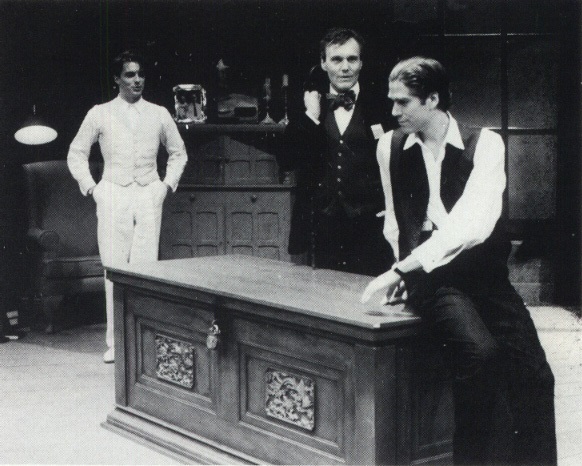
Written in 1929 by Patrick Hamilton, Rope is usually credited as the first Leopold and Loeb adaptation. Hamilton continually denied that he had heard of the case until after his play was published, but as stated by Nigel Jones in his biography of the playwright, the connections between Hamilton’s play and the murder probably had too much in common to be mere coincidence.
“[Hamilton] borrowed for his killers…Leopold and Loeb’s cold arrogance and Nietzschean pretensions; their intended method of murder; their drawn-out teasing of their victim’s parents; their close connection with the victim; their blunders; and their gradually escalating panic.”
Rope’s opening scene is the murder of a young man and the rest of the story is a suspenseful ride as the viewer waits to see if the two young killers will be discovered. The killers, Wyndham Brandon and Charles (Granno) Granillo, kill a friend of theirs as an assertion of their superiority over the common man. As they invite the victim’s friends and family over for dinner, Brandon feels compelled to tease and hint at their crime while Granno gets drunk and attempts to get through the evening without being found out. They are caught by a badly hidden ticket stub belonging to their victim rather than a pair of glasses, and the play ends with their old, presumably queer, professor damning them and speaking on behalf of society to imply that the world will reject and hang them for their crimes.
Rope has been produced many many times on stage, radio and television. For its first American run it was renamed to Rope’s End, because a different play called Rope had appeared on Broadway the year before. The name change only lasted a few months, and every other adaptation has just been called Rope. A television version from 1939 was directed by Dallas Bower, and the way he shot it allegedly influenced Hitchcock to film his movie version in as few takes as possible. It was also filmed for TV in 1947, 1950, 1953 and 1957. I have not been able to watch any of these television versions. Notable too is the 1983 radio drama, in which Alan Rickman played the professor, Rupert Cadell, which can be listened to here.
The Grindle Nightmare

In 1935 pulp horror novel The Grindle Nightmare by Quentin Patrick (a pseudonym) the story’s main villains are inspired by Leopold and Loeb. The plot focuses on a young doctor trying to solve a series of murders in a small New England town, ranging from animals to adults with no discernible pattern or motivation behind them. The two collegiate killers are added into the story along with a myriad of other potential victims/murderers and are not suspects until the very last pages.
There is some question about the sexuality of the murderers; the meek Gerald and handsome, graceful Peter. One character remarks: “Very odd how those two boys are always about together. Never seen them with a girl or anything.” But, this being the 30s, the novel does not do too much to dive into the tension between the pair (or the protagonist and his roommate for that matter). The reason for the murder is explicitly given as folie à deux, specifically folie imposée, with Peter as the more dominant partner. Leopold and Loeb themselves are mentioned as the book wraps up to compare and contrast them with the book’s killers, and it is regrettably stated that one of the differences is that Leopold and Loeb definitely raped Bobby, while Peter and Gerald never assaulted their victims.
Rope (movie)
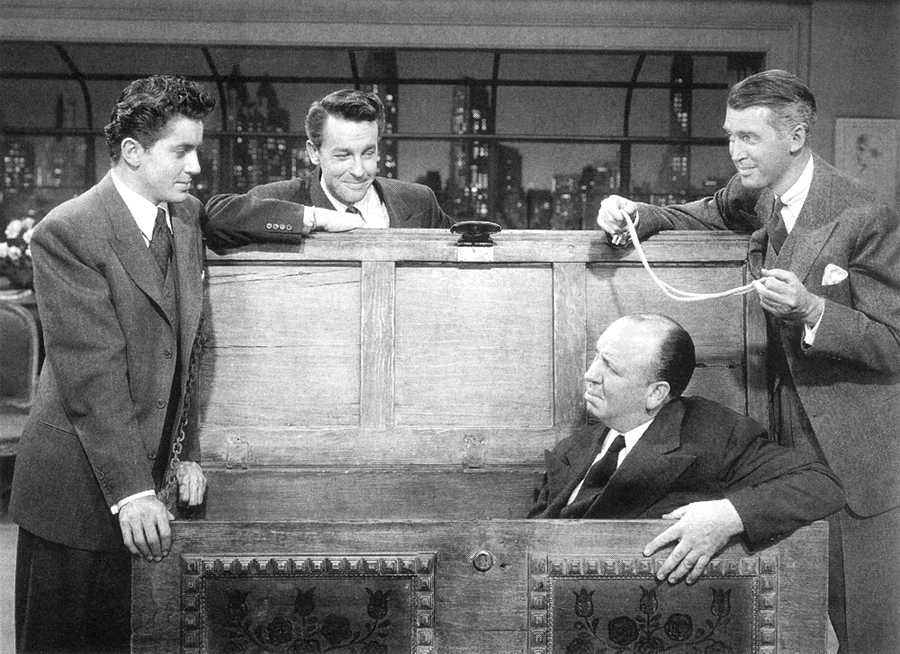
In 1948 Alfred Hitchcock filmed an adapted version of Patrick Hamilton’s play. The story was brought to New York and the names of all involved were Americanized; the two murderers changing to Brandon Shaw and Phillip Morgan. There were several other changes, but the premise remains similar to the original: two men kill a friend, hide him in a chest and then throw a dinner party. The film was shot in a series of continuous takes designed to make the movie feel like a play, and it remained thematically similar to the play as well, discussing the feelings of superiority and learned philosophy that backed the motive for murder. In a heavy-handed speech at the end of the movie James Stewart, playing the former teacher to the murderers and their victim, damns the philosophy and action he himself inspired.
Many assume that Phillip, the more passive, represents Leopold and that Brandon, the more aggressive, represents Loeb, but both characters share about an equal measure of traits and histories from each of Leopold and Loeb. Rope’s crew worked as hard as possible to sneak references to the killer’s sexualities through the censors. Though the word ‘homosexuality’ or indeed the relation to the Leopold-Loeb case was never mentioned, most of the cast and crew understood what was going on. Both killers were played by gay or bi actors who kept the relationship in mind, and Arthur Laurents, who wrote the screenplay, was gay as well, and living with Farley Granger, who played Phillip, when Rope was being written and filmed.
Rope (novelization)

Published in 1948 by the Transatlantic Pictures Corporation to coincide with the movie, the Rope novelization is mostly just a published script of the movie, but it does flesh out some of the thoughts and motivations behind the killers. The reader is given a backstory into how Phillip and Brandon met and details on the apparently platonic dominant/submissive relationship they maintained. Brandon is shown to be almost entirely devoid of emotions while Phillip is guilty and unsatisfied, only happy when he is being controlled. This is showcased in recurring imaginings Phillip has about a crumbling structure as his composure breaks down and he wants to turn on Brandon. Interestingly, the map of the apartment included on the back cover of the book does not even come close to matching that of the movie set.
The Speculator
This short story by Kenneth Strongman was published in 1972. It follows a group of four college friends, Arnold, Peter, Jim and the unnamed narrator, who are inspired by the story of Leopold and Loeb to commit a perfect crime. The group plots to murder a ‘tramp’ the following day, but when three of the friends go to collect Arnold, they find he has committed suicide. Jim and Peter are suspicious that the other murdered Arnold, and their friendship fails, though they both remain friends with the narrator. The suicide deters the group from their plan and they go on to have successful careers, though Jim and Peter are haunted by their arrogance and the possibility that they could have murdered someone. It is revealed at the end of the story that the narrator character set all the events into motion, and stole Arnold’s suicide note, which would have implicated the group and proven it was a suicide, instead of a murder. The narrator become a psychologist, using subtle manipulation on his clients, just as he had his friends, to wind them up and watch them go.
The Face of Fear (book)

The Face of Fear is a thriller published in 1977 by Dean Koontz under the pseudonym Brian Coffey. Two killers are terrorizing New York City pretending to be one man, killing and mutilating women and leaving quotes from William Blake and Nietzsche on the walls of their victims apartments. The killers, two men who are extremally close, see themselves as supermen, and compare themselves to Leopold and Loeb. The police also notice the connection and discuss the similarities to the 1924 case.
The Face of Fear (movie)

This 1990 made for TV adaptation of the 1977 Dean Koontz novel by the same name follows two killers who are pretending to be one mass murderer. While the movie removes the overt conversations about Leopold and Loeb that were in the book, the killers still quote Nietzsche and are inspired by the superman concept, so the connection can still be seen. The movie shortens many of the plot elements while adding in several action sequences.
Columbo Goes to College

This episode of the popular Columbo detective series was the first of the show’s tenth season, aired in 1990 and centers around the murder of a college Criminology professor. The killers, Cooper and Justin, are students in the professor’s class, who show immense interest in Columbo’s detective work, trying to toy with him and throw him off their trail. Because of Columbo’s sloppy clothes and bumbling attitude, they discredit and mock him, believing him too stupid to ever catch onto them. In the end, of course, they are proven wrong.
Though their motive for the murder was to prevent the professor from kicking them out of school, Justin tells Columbo as they are being arrested: “We did it because we knew how to do it.” Frederick Keller, one of the writers for the episode, acknowledged that he had been inspired by his time in a prestigious college, and wanted to show Columbo going against rich, snobby, Leopold-Loeb-type killers.
Law and Order SVU; Uncivilized
This episode of the popular true crime show aired on November 15th, 1999, episode seven of its first season. It opens with the murder of Ryan Davis, an 8-year-old boy who was assaulted, strangled and buried in a park. The obvious suspect is an adult sex offender who lives nearby and frequently rode his bike in the park where Ryan was killed. When his alibi checks out, the team brings in two eyewitnesses who led the police to this suspect earlier, teenagers named Mike D. and Jimmy G.. They tell conflicting stories about what they’d seen and once the murder weapon and the victim’s glasses are found with Jimmy’s fingerprints on them, the police begin to grill the boys.
Mike, the smarter of the two and the one with a conscience, takes the conventional Leopold role, as someone who was led astray by a sociopathic partner. The boys say the murder was not premeditated, but when Jimmy started sexually assaulting Ryan he began screaming and they strangled him with the bike chain to silence him. Jimmy, in the Loeb role, is remorseless and doesn’t care about the life he’s taken while his partner cries with guilt in the next room, unable to understand how things could have gone so wrong.
R.S.V.P.

Premiering in 2002, this comedy/horror movie is a modernization of both Hitchcock’s Rope and the Leopold-Loeb story, though it leans more heavily on the former. Spurred on by a teacher who talks about how cool murder is, student Nick kills his friend, stuffs his body in a piece of furniture and then invites their friends and Nick’s family over for a party. He then starts killing them off as well. Leopold and Loeb are referenced several times; Nick is seen researching them online and we find out that he planned this party specifically so it happens on May 21st, the same day that Leopold and Loeb murdered Bobby. According to the director, Ryan Gosling auditioned for the movie, but wasn’t cast-but he went on to star in another Leopold-Loeb modernization which came out the same year.
Murder by Numbers
Trailer * Script Comparison with 2000 version
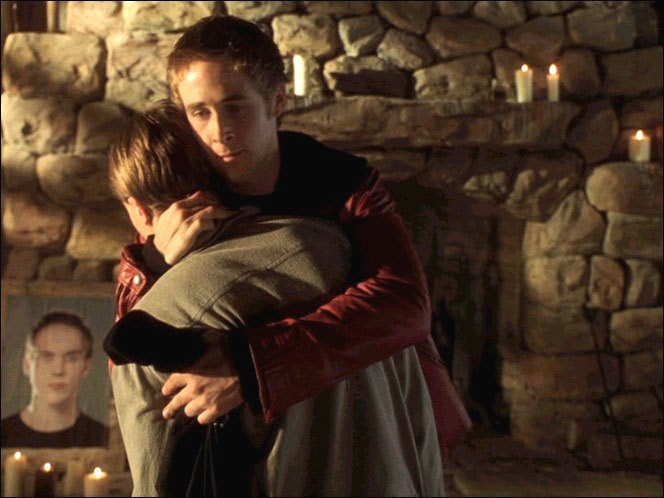
Murder by Numbers, which premiered in 2002, offers an unconventional look at the crime. Transported to the modern world of the early 2000s, the movie splits its focus between the lives of Justin Pendelton (Michael Pitt) playing the Leopold character, Richard Haywood (Ryan Gosling) playing Loeb and the investigator (Sandra Bullock) who is working to solve the murder they committed.
The film plays up the themes of wealth, superiority, precociousness and the goal of outsmarting the police that connect it to its roots. These killers, as did the teenagers they were based on, leave several clues and are caught, turning against each other in their confessions. Their relationship to each other and their true personalities are also more complicated than they first appear.
Ice Haven
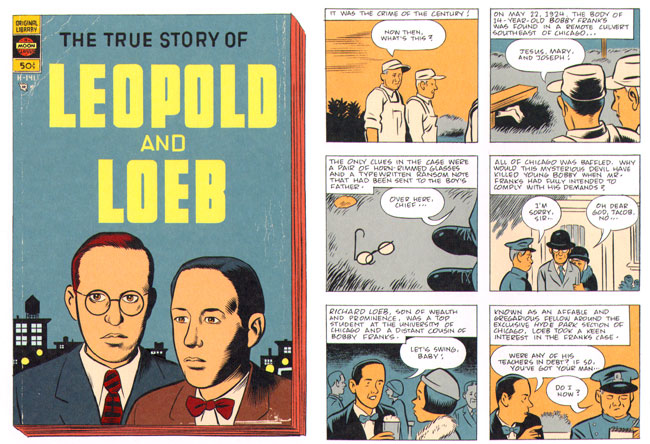
Ice Haven was adapted from an issue of the comic series Eightball, written by Daniel Clowes and published in 2001. The comics featured a series of disjointed stories which Clowes then supplemented and formatted into his graphic novel, Ice Haven, which he published in 2005. Leopold and Loeb themselves are a running theme through the stories in this work. One set of comic strips contains a basic overview of the case, another is a less realistic comic of Leopold and Loeb’s lives as they look for something to do after the Franks murder.
Their largest impact on this fictional world shows in the story of a young boy who is given a book about Leopold and Loeb by a classmate. When a murder is committed in their town, the boy becomes increasingly worried that the owner of the book was inspired to murder another child based on what he had read about Leopold and Loeb.
Rope Enough

This 2005 play by Sky Gilbert was very loosely inspired by the case. It involves two gay party boys, Ichabod and Dylan, who are in a relationship. They’re arrested for the murder of Dylan’s family and while awaiting trial, Ichabod is fond of giving a variety of ‘confessions’ and reasons for their murder. At one point he claims it was because the homosexuals they saw in the media lacked intelligence and substance, “Dylan and I did not choose that road,” Ichabod explains to a reporter. “We chose another pair of role models. Two people who were not on television. Two people who appeared before television made homosexuals banal. We chose Leopold and Loeb…There’s one thing about Leopold and Loeb, they are beautiful, and they are smart, and they are fucking, and they have real fun, and they have ideas, even though those ideas are somewhat fascistic.” It is unclear if the pair actually committed any murders at all, and if they did, for what purpose.
Maxwell’s Chain

This 2008 entry in the Peter Maxwell Mystery Series by M. J. Trow pits detective Maxwell against two of his old students: Nicholas ‘Nick’ Campbell and Richard ‘Lobber’ Underdown. When bodies start appearing Maxwell has to find the connections between the cases and unravel the codes the killers are leaving behind. It seems that everything leads back to Richard, but in the end it’s revealed that Nicholas was the brains behind the operation.
There are many references to Leopold and Loeb throughout the book. Both killers are said to have been obsessed with the case, it’s where the nickname ‘Lobber’ comes from, and when one of them booked a movie ticket it is made out to N. Leopold. At the climax Maxwell says that, like Loeb, Richard has been Nicholas’ puppet the whole time. When asked why he did it, Nicholas replies: “Because I could, that’s why.”
Murdoch Mysteries: Big Murderer On Campus
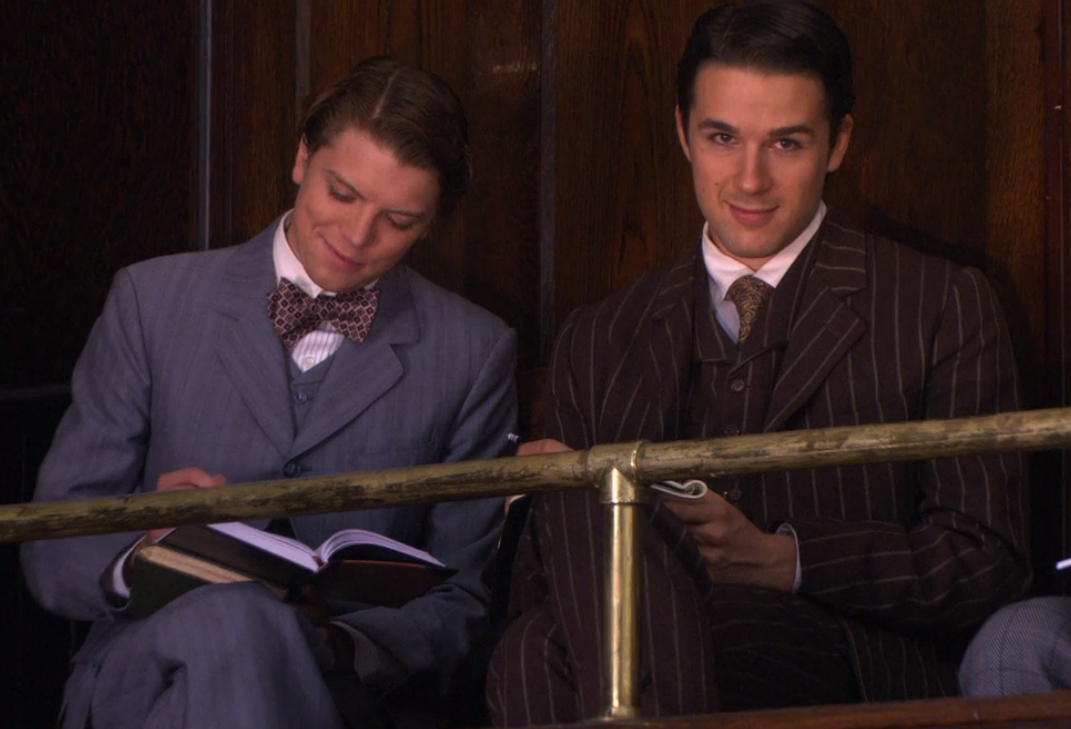
This Canadian mystery show, which focuses on the life and career of detective William Murdoch, aired an episode based on the Leopold and Loeb case in 2009. The episode begins with the murder of college professor Samuel Bennett and another professor who had a heated relationship with the victim is immediately considered the most likely suspect. Two brilliant students, Robert Perry and James Gillies, who attended the classes of both professors, are quick to give Murdoch insight into the accused professor’s personality and possible motives. They are given permission to observe the police until Robert’s handwriting is matched to a note connected to the murder.
Murdoch works to make the boys, who are implied to be lovers, turn on each other, and the police’s efforts focus on Robert, the less composed of the two. Robert eventually confesses to the murder in exchange for a lighter sentence and both are arrested in their classroom. They returned in later seasons where it is revealed that James escaped prison, sawed Robert’s head off and then began to tease and torment Murdoch. He died in the show’s seventh season after jumping from a bridge.
A Noble Killing

This 2011 novel set in Istanbul is the 13th book in the Inspector Ikmen mystery series by Barbara Nadel. In it the police try an solve several seemingly unconnected murderers, that eventually lead to a pair of high school boys, Ali Reza Zafir and Murad Emin. Murad is the Leopold character, as a deeply repressed gay boy with drug addicted parents, he turned to radical Islamic religion to try to make up for his sexuality. He’s paid to kill a ‘sinful’ man’s daughter, but after he does he’s disturbed and guilt-ridden. When he tells his friend and crush Ali about it, Ali is intrigued to see what murder will make him feel, and kills his and Murad’s piano tutor. Ali is obsessed with the Leopold-Loeb story and compares himself and Murad to them. it is this that really tips the police off to the dynamic between the pair:
“Ali Reza looked at Murad Emin and smiled. ‘It’s all going to come unraveled now,’ he said, then he laughed his spooky mad laugh again, touched his nose conspiratorially and said, ‘Leopold and Loeb, baby, Leopold and Loeb!’
Murad Emin, his previous calm demeanor now totally exploded, screamed, ‘No! No, it wasn’t like that! Not for me! it was never like that for me!’
inter Break

This 2012 novel by Merry Jones, the third in the Harper Jennings Mystery series, pits Harper against two rich fraternity brothers who aren’t as innocent as they appear. The book follows Harper stuck at home, pregnant, having to deal with her mother and her boyfriend around Christmas when she begins to notice strange things happening in and around the supposedly empty fraternity next door. Squatting there for a few days are Evan and Sty, as they kill a stranger and try to get away with his murder. While Evan is mostly into it because he enjoys killing, Sty looks at it as an interesting intellectual experience and constantly compares them to Leopold, Loeb and Nietzsche’s superman, something Evan becomes increasingly irritated with. They plan to dispose of their victim’s body and then go home for the holidays, but neither expected the ever-vigilant war veteran next door.
Criminal Minds; True Genius
Premiering in January of 2012 in the season 7 episode 11 of the TV show Criminal Minds, the team is faced with a copycat Zodiac killer, a man who turns out to be a man named Caleb Rossmore. Caleb, the Leopold character, is desperate to regain the friendship of Harvey Morell Jr, his Loeb, a man he was close to in high school, who is now getting married. Both are highly intelligent, though Harvey is successful and Caleb is stuck in a menial job. It is heavily implied that Caleb has romantic feelings for his friend, giving a speech near the beginning saying “your soul mate is standing before you” in reference to himself. He weaves an intricate map of clues for his friend to follow, hoping to bring him back to the closeness they shared when they were teenagers and killed a young boy together. The episode, while playing with location and specifics, carries the underlying themes of superiority, one-sided affection and folie a deux often seen in other adaptations and creates an interesting world in which the Leopold and Loeb characters got away with their initial murder only to get caught as middle-aged adults.
Leopold and Loeb
This short story, found in the collection Against the Hidden River and written by Michael Cox, was published in 2013. The story follows Paul and Joe as they escape from a mental hospital and wander around through the Hyde Park neighborhood. For symbolic reasons it is very important for Paul to “remember the names of two guys who killed some kid.” He eventually does. This is not an adaptation, but it seems to be inspired by the case, and there are echoes of Leopold and Loeb in the confused and lost genius of Paul’s addled mind.
The Wolf Lake Murders

This 2018 novel by Henri Jenkins takes place in the 1980s and focuses on the solving of a series of disappearances by detective Bo Boson. The Leopold and Loeb characters in this scenario are Jay “Fitz” Fitzgerald and Walter Freeman III. Walter is a serial rapist and murderer, with a taste for young Mexican boys. Hoping to distract the police who are investigating the disappearance of Walter’ boys, Fitz commits a kidnap and murder of a classmate, deliberately copycatting the Leopold-Loeb crime. Though the pair have a much higher body count than their 1924 counterparts, they all meet similar ends.
The Moralist: A Psychological Crime Thriller

This 2020 self-published novel by Joshua Marcus follows modernized versions of Leopold and Loeb, exploring what would happen if they never got caught. Nate and Dickie have grown apart in the years since they were accused of murder, but when Nate’s 14-year-old son is kidnapped and old evidence begins to resurface, he’ll be forced to confront the past he’s been trying for 20 years to forget.